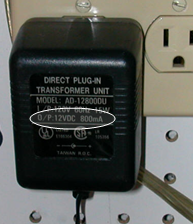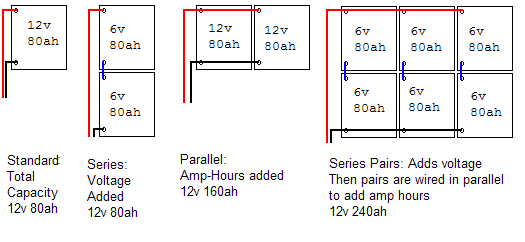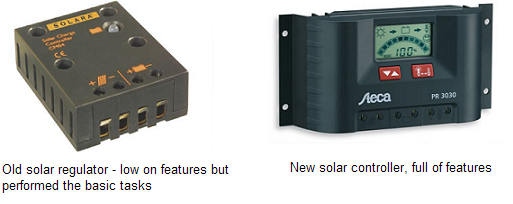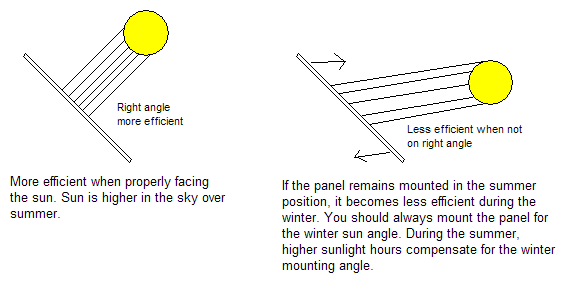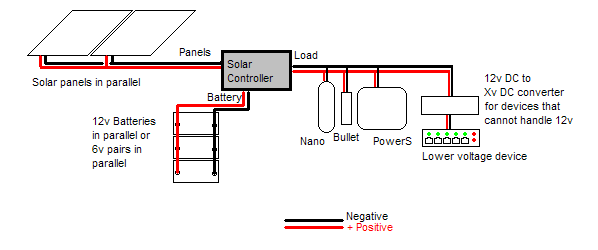By reading this, you will learn how to setup a tower in an area that does not have a grid power supply readily accessible using solar as a good alternative.
The base of working out your requirement is:
Solar Power In must be higher than Power Out.
You must capture more energy from the sun than you use.
Step 1 – How much power do you use?
To work out your power requirements, you need to look at all the radios or devices you will have on your tower. Each device will have a wattage rating which can be obtained usually by googling the model and the words watt power.
If you cannot find the watt rating of the device using Google, you can use a multimeter, or a very good device to have on hand is a product called a Kill-a-watt. A Kill-a-watt is a device with a similar shape to a surge protector with a small screen. It tells you how many watts per hour the device that you plug into it will be using.
For reference:
- Powerstation 2 6.5w
- Nanostation2 4w
- Nanostation2 Loco 4w
- Bullet2 4w – Picostation2 4w
- Bullet2HP / Pico HP 8w
Another way to work out how much power a device uses, is to look at the wall wart or transformer.
The above transformer states that it has an output of 12 volts at 800 milliamps. To convert a voltage and amp rating to watts, we multiply one by the other.
12v x 0.8a = 9.6 watts. – This transformer is capable of powering a device that uses up to 9.6 watts. The device may not use 9.6 watts and so you would need to use a multimeter or kill-a-watt to get a more accurate prediction.
Important Note:
You should always look for 12 volt equipment. If your device can not handle a 12 volt supply you will need to get a 12volt DC to X volt DC Converter which means losing some power during the conversion. The abovementioned reference devices can handle a direct connection to a 12 volt battery which makes them suitable for solar use.
Another important note is that you should only use DC devices. If the device’s transformer says it has an AC output, then it will have extra supply requirements that cost more and has a power loss through the DC to AC conversion.
Once you have worked out the watt ratings of all your devices, add them together.
If we had a PowerStation2 and a Bullet2HP, we would be using a total of 14.5 watts per hour.
To work out how many watts per day, multiply the hourly usage by 24. For our example PS2 and B2HP, we are using 348 watts per day.
Step 2 – The Battery Bank
A battery bank is used to store captured solar power for using at night or on rainy / overcast days. Your battery bank needs to be made of one or more deep cycle batterys that will run your equipment for a number of days without sunlight.
A good goal in most areas would be to run for 4 or 5 days without sunlight.
What is a deep cycle battery?
A deep cycle battery is a special type of large capacity battery which can be discharged regularly to about 50% of its capacity. They are a similar size to a car battery but the difference is the chemicals inside.
A car battery is designed to be discharged only a small amount, then recharged instantly. Discharging a car battery will leave it with a very bad memory effect and this effect worsens as it goes without being recharged. 20 large discharges may damage a car battery and stop it from ever being fully charged again, where as a deep cycle battery can handle several hundered deep discharges, and go longer without being recharged.
Even with the discharge capability of a deep cycle battery, it should never drop below 50% of its capacity, but can go several days or sometimes weeks without being recharged and still be as good as new.
A deep cycle battery will have a rating on the side. It will specify a voltage – usually 6 or 12, and an amp-hour / Ah rating. More expensive batteries will have a higher amp-hour rating and therefore have a larger capacity. It is recomended that you purchase 12 volt batteries because your solar panels will most likley be 12 volt. If you need to purchase 6 volt batteries, they can be wired in a special way to increase the voltage to 12. You can purchase more batteries to add capacity as we will see below.
Wiring Methods
There are 2 ways to wire batteries together. You can use both at the same time if you like.
- Parallel: This means that the amp-hour capacity of the batteries will be added together
- Series: This means that the voltage of the batteries will be added together
So what size battery bank do you need?
You will need a battery bank that will run your tower for a set amount of days without sunlight, and still not be discharged more than 50%. To work this out, we take the daily power usage, multiply it by the number of days , and then multiply again by 2 so we factor in the 50% discharge limit.
In the example above of a PS2 and a B2HP, we need 4 days of 348 watts, multiplied by 2. This means our battery bank capacity needs to be 2,784 watts.
To convert the watts back to amp-hours, we would divide by the battery voltage rating (12) so 2784 / 12 = 232 Ah total. Lets just round this to 240 Ah.
To achieve this, we could have:
- 2x 6 volt 240Ah wired in series
- 2x 6 volt 120Ah batteries wired in series -parallel- to another pair of 2x 6 volt 120Ah wired in series
- 2x 12 volt 120Ah batteries wired in parallel.
Types of Batteries
- Flooded / Wet Cells: The older and more common type of deep cycle battery. Needs maintanence such as water topups. Water is lost in gases when charging.
- Gel or AGM: Are sealed and maintanence free. There is no gas lost becuase the battery case is sealed and a special solar controller needs to be used so that the built up pressure from the gasses does not damage the battery. Gel or AGM are able to deliver more power, faster and so are ideal for starting engines or using on boats. They work well for our WISP radio towers too.
Step 3 – What size panel do you need?
This depends upon the average daily sunlight hours in your area during winter time.
- Insolaton is the correct measurement to use. Insolation is a measurement of the sun’s energy that reaches a specific area of the earth’s surface. It is more accurate than sunlight hours as it takes into account the angle of the sun, and various other environmental factors. Sunlight hours can easily be used where you are using less than 20 watts of load
In the example scenario, we have 4 hours each day on average during the winter months. You can find out your area’s sunlight hours from your local weather agency.
The solar panel will need to be able to capture enough solar power to run your equipment for the day, as well as recharge your battery bank following a rainy or overcast period. It also needs to be able to do this during winter.
So if the example has 4 hours of sunlight to capture 24 hours worth of power (348 watts), that’s a basic requirement of an 87 watt solar panel. (348 / 4 = 87 watts per hour.
Now we need to factor in the recharging after a rainy or overcast period. If it rained for 4 days, and on the 5th day it was sunny, thats 5 days worth of power that needs to be captured. In the example thats 1,740 watts worth of power. We also need to capture this power as fast as possible before it rains again. So to capture 1,740 watts of power during 4 hours of sunlight, that means we need a 435 watt panel. If we wanted to, we could set a goal of recharging the batteries over 2 days. That means we have 8 hours to capture 6 days worth of power – which a 260 watt panel would be able to do. If you decide to set a longer recharge period, you can save some money on solar panels, but will need to spend more on adding more capacity to your battery bank incase you only get one sunny day and it returns to rain.
It is also probable that if you have an average of 4 hours of sunlight per day in winter, that also means half the days will be rainy or overcast, and the other half would be sunny. This means that on the sunny day, there could be up to 8 hours to capture the required power instead of the 4 assumed above. It is best to oversize your panels just in case, so you should not rely too much on extra average sunlight hours from rainy days.
Types of Solar Panels
- Polycrystalline: Are cheaper to produce, but are not as efficient as mono. Panels are usually larger for the same watt rating.
- Monocrystalline: Are more expensive to produce but are more efficient than poly and can capture the more watts per square foot of solar cells.
Overcast Days: Some panels will still capture solar energy when there is a light overcast of cloud (bright white clouds) and they can sometimes work at up to 40% of the panel’s rating. You may be interested in checking how your panel performs by using a multimeter and testing the panel’s output on an overcast day.
Next we will look at the bit that joins everything together.
Step 4 – The Solar Controller
A solar controller can perform 6 main tasks:
- Prevents power from the battery traveling back up and getting lost through the solar panel at night
- Prevents the panels from overcharging the battery by disconnecting them when the battery is full
- Gives an indication on the battery bank’s State Of Charge
- Stops the batteries from being discharged too much by disconnecting your devices when the battery SOC gets too low.
- Counts how much power you have generated and how much power your devices have used
- Helps lower the amount of maintanence work required on your batteries by charging in certain ways
Old solar controllers used to be called solar regulators. This is simply because they stopped the battery getting overcharged and would simply use a relay and volt metre to check when to disconnect or reconnect the panel.
You will want to make sure you get a solar controller that will display the state of charge for your battery bank. This helps diagnose problems if your tower stops working and your customers need it fixed urgently.
Sizing solar controllers
Your panels will have a maximum amp output current. If you have wired your panels in parallel, you will need to add together the maximum amp output current of each of them – you will want a controller that can handle at least this amount with pleanty of capacity to spare. It may be wise to purchase a controller that handles double the current than what you need in case you wish to add more radios or panels in the future.
Also check if you have used gel or liquid flooded batteries and that the controller or regulator will work with your batteries. This is especially true if you use AGM or gel batteries. The controller needs to be set to charge in a specific way so that it doesnt cause high gas pressure inside the sealed battery. Flooded batteries need ventilation becuase they are not completely sealed and gasses escape when charging.
The Load Output
One important feature of a solar controller is the load output. This is where you connect your devices. You must be careful with this feature though. Some controllers assume it will be to automatically control lighting and so switches the load output on in the evening and off during the day. For our 24-hour radios, you need to make sure the load output can be switched on all the time and will not turn off by any automatic feature before purchasing the controller. Some controllers like the Steca brand pictured above-right, allow you to press a button to switch the load on or off, or use the menu to enable automatic functions such as turning it on x hours after darkness and off in the morning. The important thing is that it does allow the manual-only switching mode.
Step 5 – Mounting the panels
You will want to mount your panel so its surface is perpendicular to the sun’s rays during winter.
During winter, the sun will be on a lower angle than in summer. Because there is more sunlight hours in summer, we are not too concerned if the panel is less efficient because of its angle but in winter, it makes more of a difference. You should therefore mount your solar panel so it is most efficient in the winter.
Here is a link to a website that further explains how to mount your solar panel and calculate the angles. It gives examples for a hot water solar collector but the angles will be the same for a solar power panel. Solar Direct’s Angle Guide.
Step 6 – Hooking it all up
Step 7 – The worst has happend – the bank is flat
So what do you do when you find its been raining for too long and your battery bank has gone flat.
Ideally you should have:
- A portable generator of around 300 watt with 12v DC and mains AC outputs – make sure the amp output of the 12v is less than your solar controllers limitation.
- A few backup batteries or pairs of batteries to swap into to your bank to run your tower for 2 days.
The first step would be to check the solar controller. Some with lcd screens will show an error code to help you diagnose the problem. If its just been raining too long then you will need to add another solar panel and expand the size of your battery bank to prevent it from happening again.
You can disconnect your solar panels, and connect the solar panel input of your solar controller to the 12v output of the generator and safely charge the battery bank and run your tower again. For faster charging, you would disconnect the batteries from the solar controller and directly connect them to the 12v output of the generator.Another way is to take out some fully charged batteries from your workshop and connect them in parallel to your battery bank – this will flow on to power your devices and slightly charge some of your batteries.
No matter what you do to get it going, the fact is that you have to work out what caused the issues, fix it as soon as possible and power up your tower or risk loosing customers. It is not a good for your customer’s internet access to disconnect after x amount of days of rain because your battery bank is not big enough to suit your local area.

